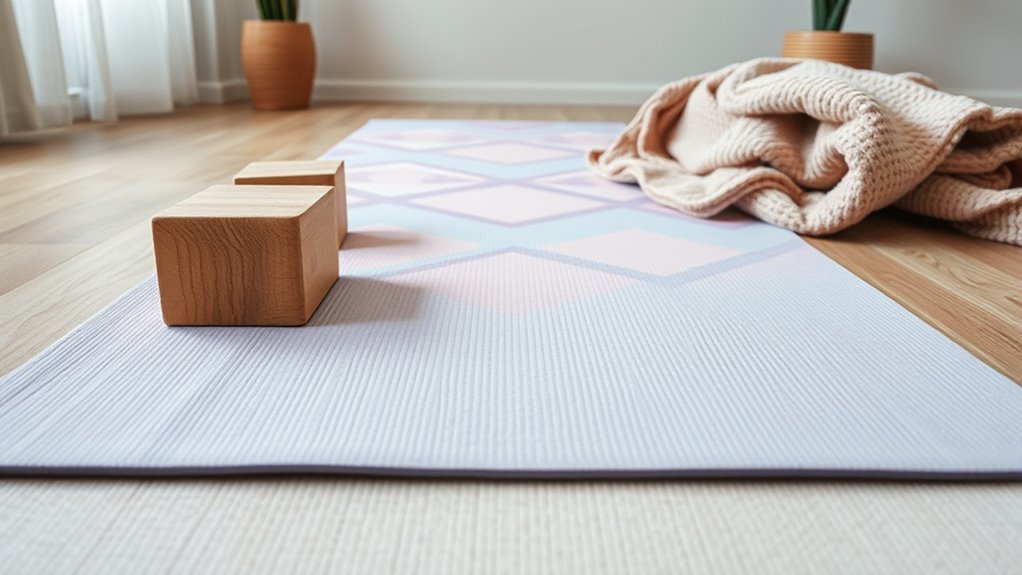If you’re looking for the best non-slip yoga mats for beginners in 2025, I’ve got you covered. I recommend considering options like instructional mats with guidance features, eco-friendly materials, and good cushioning for comfort. Mats from brands like Gaiam and Retrospec are popular for their grip and durability. Each one suits different needs, whether you want extra support or portability. Keep going, and you’ll discover the perfect mat to build your confidence on your yoga journey.
Key Takeaways
- Look for mats with textured, non-slip surfaces made from PVC, TPE, or rubber for optimal grip during sweaty practice.
- Prioritize mats with adequate thickness (4-6mm) to provide cushioning and joint support without sacrificing stability.
- Choose eco-friendly, durable materials like recycled PVC or natural rubber to ensure safety and sustainability.
- Ensure the mat size is at least 68” long and 24” wide for ample space and comfort for beginners.
- Consider lightweight, portable options with easy-clean features for convenience and long-term use.
Instructional Yoga Mat with Carrying Strap

If you’re new to yoga and want guidance without constantly looking at a screen, the Instructional Yoga Mat with Carrying Strap is an excellent choice. It features 75 illustrated poses and stretching exercises, making it perfect for self-guided practice or following along in class. Its size, at 68”x24”, offers plenty of space, while the 1/4-inch thickness provides cushioned comfort to protect your knees and joints. The included strap makes it easy to carry, so you can practice anywhere. Made from non-toxic, eco-friendly PVC, it’s durable, odor-free, and safe. This versatile mat is suitable for all skill levels and promotes confident, independent practice.
Best For: beginners and experienced yogis seeking a portable, illustrated guide to improve their practice independently.
Pros:
- Features 75 illustrated yoga poses and stretching exercises for comprehensive guidance.
- Large 68”x24” size with 1/4-inch thickness provides ample space and cushioning for comfort and stability.
- Includes a carrying strap for easy transport, making it convenient to practice anywhere.
Cons:
- The PVC material, while eco-friendly, may not appeal to those preferring natural or biodegradable options.
- The detailed illustrations may be overwhelming for absolute beginners who prefer simple routines.
- Slightly heavier than minimalist mats, which could be less ideal for highly mobile practitioners.
Gaiam Print Yoga Mat for Yoga, Pilates & Floor Exercises

Looking for a versatile yoga mat that balances comfort, grip, and eco-friendliness? The Gaiam Print Yoga Mat is perfect for all yoga styles, Pilates, and floor exercises. It’s lightweight yet durable, offering excellent cushioning for your joints. The textured, sticky surface provides superior traction and grip, helping you stay stable during challenging poses. Made from non-toxic, environmentally friendly PVC free from harmful chemicals, it’s safe for both you and the planet. With dimensions of 68 inches long, 24 inches wide, and 4mm thick, it gives ample space and comfort. Plus, a free workout download helps beginners get started confidently.
Best For: practitioners of all yoga styles, Pilates enthusiasts, and floor exercisers seeking a comfortable, eco-friendly, and non-slip mat.
Pros:
- Provides excellent cushioning and joint support with a 4mm thickness
- Features a textured, non-slip surface for superior grip and stability
- Made from non-toxic, environmentally friendly PVC free from harmful chemicals
Cons:
- May have a slight odor initially that requires airing out before use
- Lightweight design might be less stable on uneven surfaces
- Limited color options depending on availability
Retrospec Solana Yoga Mat (72x24in) with Nylon Strap

The Retrospec Solana Yoga Mat stands out as an excellent choice for beginners seeking comfort and stability during their practice. Its 1/2-inch thickness offers ample cushioning, protecting joints and making poses more comfortable. The non-slip surface grips floors securely, helping you stay stable and focused without slipping. Built for durability, it handles daily use whether at home or in a studio. The included nylon strap makes carrying effortless, perfect for on-the-go practice. Made from BPA-free materials, it’s easy to clean and maintain hygiene. Overall, this mat combines comfort, safety, and convenience, making it a reliable option for newcomers to yoga.
Best For: Beginners and those seeking a comfortable, stable, and portable yoga mat for home or studio use.
Pros:
- 1/2-inch thick cushioning provides excellent joint and knee support.
- Non-slip surface ensures safety and stability during routines.
- Lightweight with a nylon strap for easy transport and storage.
Cons:
- May be too thick for advanced practitioners preferring a closer-to-the-floor feel.
- Nylon strap might wear over time with frequent use.
- Limited color options might not appeal to all aesthetic preferences.
Gaiam Essentials Yoga & Pilates Exercise Mat with Carrier Strap

For beginners seeking a reliable and comfortable yoga mat, the Gaiam Essentials Yoga & Pilates Exercise Mat with Carrier Strap stands out thanks to its thick, high-density NBR foam that provides excellent cushioning. At 10mm thick, it reduces sore knees and stiff joints, making it ideal for floor workouts, Pilates, and stretching. The textured, non-slip surface ensures stability during sweaty or dynamic exercises, while its durable, tear-resistant build withstands regular use. Lightweight and measuring 72 x 24 inches, it’s easy to carry with the included adjustable strap. Plus, its eco-friendly, low-odor materials make it a safe, practical choice for everyday practice.
Best For: beginners and fitness enthusiasts seeking a comfortable, durable, and portable yoga or Pilates mat ideal for floor exercises, stretching, and low-impact workouts.
Pros:
- Thick 10mm high-density NBR foam offers excellent cushioning and joint support.
- Textured, non-slip surface provides stability during sweaty or dynamic movements.
- Lightweight with an adjustable carrying strap for easy portability and storage.
Cons:
- Slightly heavier than thinner mats, which may be less convenient for some users.
- May retain odors initially due to eco-friendly materials, requiring airing out.
- 0.39-inch thickness might be too thick for those preferring a more grounded feel during certain poses.
Gaiam Yoga Mat, 6mm Thick Non-Slip Exercise & Fitness Mat

If you’re new to yoga or floor workouts, the Gaiam Yoga Mat’s 6mm thickness offers the perfect balance of cushioning and stability. I love how its textured, non-slip surface provides excellent grip, so I feel secure during every pose. Made from non-toxic, eco-friendly PVC, it’s safe and free of harmful chemicals, though I recommend airing it out before use. The extra cushioning protects my joints without adding bulk, and it’s lightweight enough to carry easily. Plus, the included free workout makes it a great choice for beginners looking to build confidence and improve their practice.
Best For: beginners and intermediate yoga practitioners seeking a comfortable, eco-friendly, and non-slip mat for diverse floor exercises.
Pros:
- Excellent cushioning with 6mm thickness provides joint protection and stability.
- Textured, non-slip surface ensures superior grip and safety during poses.
- Made from non-toxic, eco-friendly PVC with a harmless odor, promoting a healthier workout environment.
Cons:
- May have a slight odor initially, requiring airing out before use.
- Slightly heavier than thinner mats, which might affect portability for some users.
- The textured surface, while providing grip, may be more difficult to clean thoroughly.
Factors to Consider When Choosing a Yoga Mat for Beginners Non Slip

When selecting a non-slip yoga mat, I look at the surface material to guarantee it provides good grip and comfort. I also consider thickness for cushioning and how portable it is for my practice space. Finally, I keep eco-friendly features and durability in mind to find a mat that lasts and aligns with my values.
Non-Slip Surface Material
Choosing the right non-slip surface material is essential for beginners seeking stability and safety during yoga practice. Textured materials like PVC, TPE, or rubber offer excellent grip, reducing the chance of slipping, especially during sweaty or vigorous poses. The surface’s tackiness and friction level are pivotal for maintaining balance and preventing falls. Some mats feature patterns or ridges that improve grip on smooth floors, boosting confidence during challenging moves. Additionally, the durability of the material determines how well the mat retains its traction over time, even with regular use. A high-quality non-slip surface not only keeps you safe but also helps maintain proper alignment, making your practice more effective. Choosing the right material is a key step toward a secure and enjoyable yoga experience.
Cushioning and Thickness
Cushioning and thickness play a essential role in ensuring a comfortable and stable yoga practice for beginners. Thicker mats, usually 4-6mm, offer more padding, reducing pressure on joints and making poses more comfortable. However, too much thickness can compromise stability, making it harder to balance in certain poses. Finding the right balance is key; adequate cushioning prevents soreness and discomfort, especially for those still building strength and flexibility. A properly chosen thickness provides enough shock absorption without sacrificing grip and control. This balance helps you practice safely and confidently, ensuring that your movements are supported without feeling unstable. Ultimately, selecting a mat with the right cushioning enhances your overall experience, making your yoga journey more enjoyable and effective.
Size and Portability
Finding the right size and weight for your yoga mat makes a big difference in how comfortably and conveniently you can practice. A mat at least 68 inches long gives enough space for most poses, while a 24-inch width provides enough room to move freely without feeling restricted. If you attend classes or practice outdoors, a lightweight mat—around 2 to 4 pounds—is ideal for easy transport and storage. Look for mats with a carrying strap or handle to make portability even simpler. It’s essential to choose a size and weight that fit your storage options and personal convenience, so you’re encouraged to stick with your practice consistently. A well-sized, lightweight mat can make your yoga experience more enjoyable and accessible.
Durability and Wear
Since a yoga mat’s durability directly affects how long it stays supportive and safe, I always look for high-quality materials like high-density PVC or NBR foam. These materials resist tears, cracks, and flattening over time, maintaining cushioning and grip. Thicker mats, around 4mm or more, tend to withstand more pressure and wear, extending their lifespan. I also pay attention to reinforced edges and non-slip surfaces, which help prevent premature deterioration. Proper maintenance, like regular cleaning and airing out, is essential to avoid dirt, sweat, and odor buildup that can weaken the material. Investing in a well-constructed mat guarantees it remains functional and safe through many sessions, making it a worthwhile choice for beginners seeking durability and longevity.
Eco-Friendly Features
Choosing a yoga mat that’s eco-friendly not only benefits the environment but also creates a healthier practice space. I look for mats made from natural rubber, jute, or recycled PVC, which reduce environmental impact and often carry certifications like SGS or OEKO-TEX, ensuring safety and sustainability. These mats avoid harmful chemicals such as phthalates, heavy metals, and VOCs, making them safer for indoor air quality. Plus, eco-friendly mats are biodegradable or recyclable, helping to minimize waste in landfills over time. Using environmentally conscious materials promotes a cleaner, safer environment for my practice. I feel good knowing my choice supports sustainability and reduces the presence of toxins, creating a more mindful experience both on and off the mat.
Price and Value
When selecting a yoga mat for beginners, evaluating the price versus the features it offers is vital to guarantee you’re getting good value. A higher price often means better cushioning, durable materials, and a non-slip surface that boost safety and comfort. These features can prevent injuries and make your practice more enjoyable. However, budget-friendly options can still support beginners if chosen carefully, even if they lack some advanced grip or durability. It’s important to consider the overall value by examining the material, thickness, grip, and longevity relative to the cost. Investing a bit more in a mat with textured non-slip surfaces can pay off in the long run by extending its lifespan and enhancing your safety during practice.
Frequently Asked Questions
Are Non-Slip Yoga Mats Suitable for All Types of Yoga?
Yes, non-slip yoga mats are suitable for all types of yoga. I find they provide excellent grip, whether I’m doing gentle stretches or more intense poses like vinyasa or power yoga. They help prevent slips and injuries, making my practice safer and more comfortable. No matter your style, investing in a good non-slip mat can really enhance your overall experience and confidence on the mat.
How Often Should I Replace My Non-Slip Yoga Mat?
I replace my non-slip yoga mat every 12 to 18 months, just like changing the tires on a car to keep things safe. Over time, dirt, sweat, and wear reduce its grip and cushioning. I’ve learned to check for thinning areas, persistent odors, or cracks—those signals it’s time for a new one. Regular replacement keeps my practice safe, comfortable, and grounded, just like a solid foundation.
Can a Non-Slip Mat Help Prevent Injuries During Practice?
Yes, a non-slip yoga mat can definitely help prevent injuries during practice. I’ve found that when my mat grips well, I’m less likely to slip or lose balance, especially during challenging poses or sweaty sessions. This added stability keeps my joints safe and reduces the risk of falls. Investing in a good non-slip mat gives me confidence and supports my practice, making it safer and more enjoyable.
Are There Eco-Friendly Non-Slip Yoga Mats Available?
Yes, eco-friendly non-slip yoga mats are definitely available. I’ve found options made from sustainable materials like cork, jute, and natural rubber that offer excellent grip and are kind to the environment. These mats not only help you maintain stability during your practice but also reduce your ecological footprint. If you’re looking for a greener choice, I recommend exploring brands that focus on sustainability and non-slip performance.
What Is the Best Way to Clean and Maintain a Non-Slip Yoga Mat?
To keep my non-slip yoga mat clean and grip-ready, I give it a quick wipe after each session with a mixture of water and a few drops of gentle soap or vinegar. I avoid harsh chemicals that can damage the surface. I also hang it to air dry and store it flat to prevent warping. Regular cleaning maintains its traction and extends its lifespan, making my practice safer and more enjoyable.
Conclusion
Ready to start your yoga journey? With the right non-slip mat, you’ll feel confident and secure on your mat every time. Remember, it’s not just about the poses but about enjoying each moment and honoring your body. So, aren’t you ready to invest in a mat that supports your progress and keeps you safe? Your practice deserves the best—go ahead, choose the one that feels right for you and embrace your yoga journey today.








